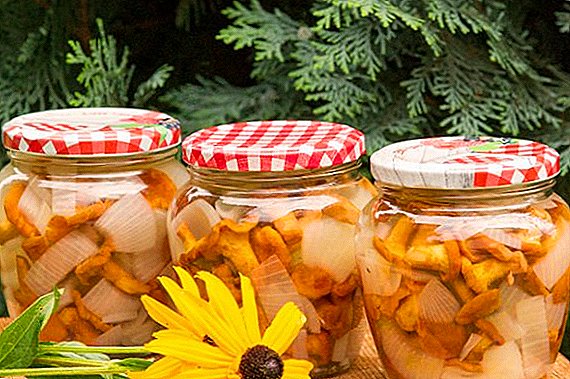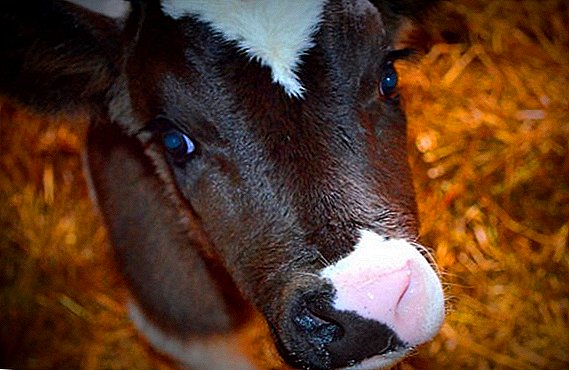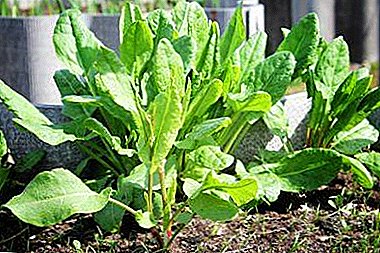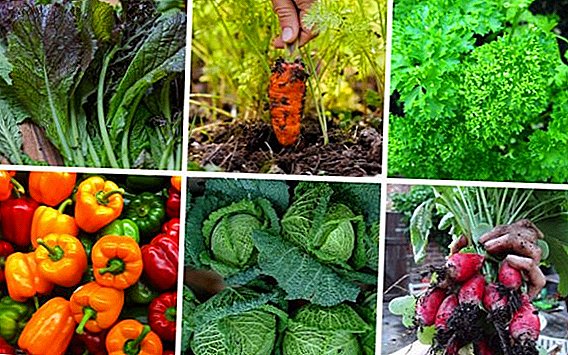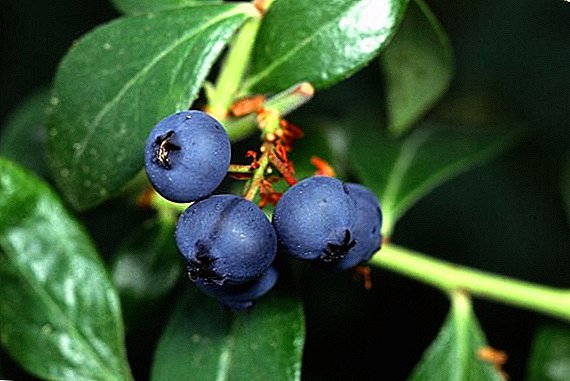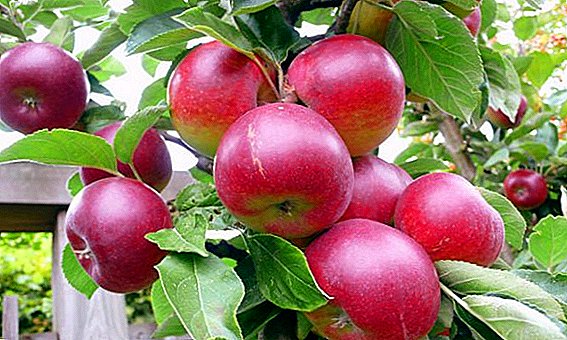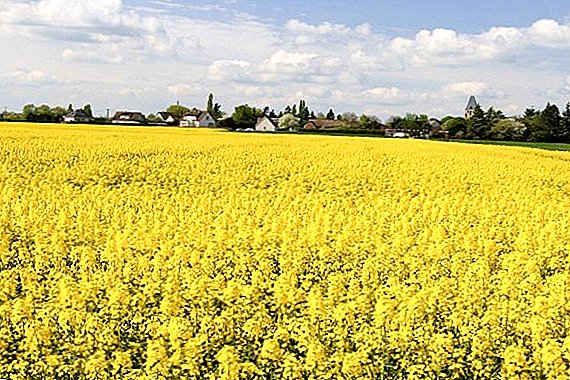 Rape - Annual cruciferous, a crop that has been cultivated for more than six thousand years.
Rape - Annual cruciferous, a crop that has been cultivated for more than six thousand years.
Soil preparation and fertilization for rapeseed
Rape grows well on chernozems with a slightly acid reaction. The soil in the plots should be well cleaned of weeds, as in the developmental stage, seedlings are inhibited under the influence of weeds. On heavy soils, deep plowing is used, due to the turnover of a large stratum, too dense soil is loosened, small lumps are broken and the soil is saturated with oxygen. This method contributes to the development of the root system of the plant, levels the soil surface for seeds. For winter rape, even soil with small lumps matters, for this, after deep plowing, the soil is well leveled with a cultivator to the depth of sowing of seeds.
Important! These activities should be carried out as quickly as possible so that the soil does not dry out.
 Up to thirty percent of the nutrients canola is absorbed from the soil, the rest of the nutrition needs to be provided mineral and organic fertilizers. Well, if the organic was introduced under the previous culture. For the qualitative development of seedlings and high yields of rapeseed is made nitrogen. With help phosphorus plant rosettes are laid, as well as the root system. Potassium compounds improve the synthesis of rapeseed tissue, increase resistance to cold.
Up to thirty percent of the nutrients canola is absorbed from the soil, the rest of the nutrition needs to be provided mineral and organic fertilizers. Well, if the organic was introduced under the previous culture. For the qualitative development of seedlings and high yields of rapeseed is made nitrogen. With help phosphorus plant rosettes are laid, as well as the root system. Potassium compounds improve the synthesis of rapeseed tissue, increase resistance to cold.
Seed preparation for sowing
Rapeseed seeds do not need to ripen long after harvesting, they are enough to clean and dry. Two weeks before sowing, seeds are pickled with Royalfla (30 liters per ton of seed).
Seeds suitable for planting should have the following qualities:
- 1000 seeds in weight from 3 to 7 g;
- purity 96-98%;
- germination rate up to 96%;
- humidity not higher than 12%.
Did you know? Canola was known and used as early as 4000 BC. Scientists argue about its origin, as in the wild rape does not grow.
Planting and care of rapeseed
 Rape after successful planting, pre-sowing cleaning and fertilizing the soil, also needs careful care. Fertilizers are equally important in the growth of shoots: these are elements such as sulfur, magnesium, boron, manganese, molybdenum, copper, zinc and cobalt. With a lack of boron, for example, the stem of the plant thickens, and flowering is delayed, and without sulfur the pods may not even begin to form. Therefore, in the process of leaving the missing substances are made in the form of dressings.
Rape after successful planting, pre-sowing cleaning and fertilizing the soil, also needs careful care. Fertilizers are equally important in the growth of shoots: these are elements such as sulfur, magnesium, boron, manganese, molybdenum, copper, zinc and cobalt. With a lack of boron, for example, the stem of the plant thickens, and flowering is delayed, and without sulfur the pods may not even begin to form. Therefore, in the process of leaving the missing substances are made in the form of dressings.
Winter rape
The optimal time for sowing seeds of winter rapeseed is held in late August. By winter, the plant has a height of up to 25 cm and about eight leaves. Such a sprout is able to overwinter without consequences. Winter rapeseed grows well on fertilized loam or sandy soil. Too acidic soils do not suit him, as well as stagnant moisture. You can prepare the plot with the help of a cultivator or Fokin planer. Calculation of seeds: 200 g per 100 square meters. m. The depth of sowing is about 3 cm, between the rows - 30 cm.
Spring rape
When sowing rape in spring, determines the temperature of the soil. At the depth of planting the soil should have a temperature of -5 to -7 ° C. Under such conditions, crops are not attacked by pests and can compete with weeds. Spring rape is usually sown in early spring. With the lower case sowing method, the depth is 2 cm, the width between the rows is 15 cm. Further, the plant density is 120 pieces per square meter.
Weed, pest and disease control
 When rape is planted, it is necessary to clear the soil of weeds, but not the fact that the seeds of the latter do not remain, and they will not germinate along with the seedlings of rape. The following drugs are used against the occurrence of weeds: "Butizan", "Fusilad" and "Lontrel" (helps with the dominance of the black-headed and the bedstraw).
When rape is planted, it is necessary to clear the soil of weeds, but not the fact that the seeds of the latter do not remain, and they will not germinate along with the seedlings of rape. The following drugs are used against the occurrence of weeds: "Butizan", "Fusilad" and "Lontrel" (helps with the dominance of the black-headed and the bedstraw).
The most terrible pests for rape are cruciferous flea and rapeseed flowering beetle. In the fight against these insects help drugs "Alpha", "Decis" and "Fastak." During the period of growth and development, the plant is susceptible to fungal diseases, such as Alternaria, peronosporoz, sclerotinia. In this case, it is necessary to spray planting solutions of fungicides.
Optimum time for harvesting rapeseed
Harvesting rape has its own nuances: since it blooms unevenly, it matures at different times.
Winter rapeseed
Due to uneven ripening, there is a possibility of losing a certain amount of crop, as ripe pods begin to crack. Rapeseed is harvested by direct combining (on small areas of non-industrial value, use Fokin's flat cutter). Harvesting starts at full ripeness, the moisture content of the seeds should be from 9 to 12%. At a lower rate increases the loss. For crops clogged with a strong difference in ripening, separate cleaning is used. Seed moisture should be from 35 to 45%, the pods are yellow-green.
Spring rape
 Spring rapeseed harvesting is almost the same as winter harvesting. If the rapeseed fields are heavily clogged with chamomile or bed-bed, planting is sprayed with desiccants. Spraying is carried out at the beginning of ripening ("Basta") or at full maturity ("Reglon"). A week after the procedure, you can start cleaning. The moisture content of the seeds should be up to 20%.
Spring rapeseed harvesting is almost the same as winter harvesting. If the rapeseed fields are heavily clogged with chamomile or bed-bed, planting is sprayed with desiccants. Spraying is carried out at the beginning of ripening ("Basta") or at full maturity ("Reglon"). A week after the procedure, you can start cleaning. The moisture content of the seeds should be up to 20%.
Attention! It is advisable to clean the high cut 5 cm below the lowest pod. Seeds get less moisture from the straw.
The effect of rapeseed on the soil
There is an opinion that canola kills the soil. This is not true. The advantages of sowing rape:
- quickly frees up the field
- improves soil composition, reduces the risk of water and wind erosion, reduces weed infestation,
This plant improves soil structure: The root system of rape deeply loosens the ground, absorbs nitrates and improves the productivity of crop rotation. The winter variety, after harvesting, leaves organic residues in the soil, fertilizing it. Canola destroys rot in the soil, affecting the roots of plants. The plant is an ideal predecessor for cereals, whose yield increases without any special costs.
Rapeseed storage
 After harvesting, rapeseed seeds need to be cleaned and dried. Oilseed rapeseed also has an effect on storage. For normal storage you need to dry up to 8-9% moisture. They clean the seeds from various green residues in special sieves. To make the sieve less clogged, it is better to use the construction with slots, and not with round holes. Reduce moisture with thermal dryers or fans.
After harvesting, rapeseed seeds need to be cleaned and dried. Oilseed rapeseed also has an effect on storage. For normal storage you need to dry up to 8-9% moisture. They clean the seeds from various green residues in special sieves. To make the sieve less clogged, it is better to use the construction with slots, and not with round holes. Reduce moisture with thermal dryers or fans.
The higher the moisture content in the seeds, the higher the drying temperature. At a humidity of 12%, the temperature should be up to 65 ° C. After drying, the seeds need to be cooled for long-term storage. In farms in which there are no dryers and powerful ventilation systems, the seeds are dried in large areas. They do it in sunny weather, scattering seeds a layer not thicker than five centimeters. Seeds need to be turned frequently. The seeds should be stored in a dry ventilated room at a temperature below 5 ° C.
The use of rape in different areas
Rapeseed oil is used in various spheres of our life. It is used in the printing industry, in the leather and textile industry, in the chemical, fuel and agricultural industries.
Rapeseed oil - the benefits and harm
 The composition of rapeseed oil is similar to olive oil. It contains the necessary human body monounsaturated fats, Omega 3, 6, 9 acids. The oil is rich in vitamin E and linoleic acid. Omega acids prevent the thinning of blood vessels, prevent the occurrence of blood clots, reduce cholesterol plaques. These same acids and linoleic acid stimulate heart activity.
The composition of rapeseed oil is similar to olive oil. It contains the necessary human body monounsaturated fats, Omega 3, 6, 9 acids. The oil is rich in vitamin E and linoleic acid. Omega acids prevent the thinning of blood vessels, prevent the occurrence of blood clots, reduce cholesterol plaques. These same acids and linoleic acid stimulate heart activity.
Vitamin E activates the immune system, strengthens the protective functions of the body. Eating rapeseed oil in food helps the gastrointestinal tract. The beneficial properties of rapeseed are especially valuable for women. The oil contains the hormone estradiol, corresponding to the female hormone. It significantly reduces the risk of malignant breast tumors, increases reproductive function in women.
A serious disadvantage is the presence of erucic acid in the oil. But nowadays oil, which is produced for food purposes, does not contain a large amount of this substance. It is undesirable to use rapeseed oil to people suffering from hepatitis, it is also possible individual intolerance to the product.
In cosmetology
 Rapeseed in cosmetology is used for skin care and in the elimination of dermatological problems. If you add oil to the hair care product, they will become lush, shiny, strong, damaged hair will be restored, and brittleness will disappear.
Rapeseed in cosmetology is used for skin care and in the elimination of dermatological problems. If you add oil to the hair care product, they will become lush, shiny, strong, damaged hair will be restored, and brittleness will disappear.
To protect the skin of the face and hands from weathering in frosty weather, make masks with the addition of rapeseed oil. Mask of oil, lemon juice and banana significantly whiten the skin. If you add coarse ground coffee to this mask, you get a scrub. Masks with the use of rapeseed oil tone, regenerate and nourish the skin. With the help of rapeseed-based products, you can care for the scalp, hands, neck, face and décolleté.
Rapeseed Biofuel
Given the state of ecology, scientists around the world are developing options for non-toxic and safe fuels. Rapeseed oil firmly occupies one of the leading places in this niche. The use of such fuel reduces the consumption of oil and the harmful effects on the atmosphere. The leader in the production of biodiesel rapeseed fuel is Germany. More than one million hectares of land has been allocated for the cultivation of rapeseed in the country, which is about 10% of all agricultural land.
Interesting! The cost of a liter of biofuel at a gas station in Germany is 0.75 euros, for comparison, a conventional diesel fuel costs 0.90 euros per liter.
 So what is rapeseed oil? Of course - This is primarily a useful product, especially when you consider that its production takes 14% of the total world production of vegetable oils. It is a food product for humans and animals, raw materials for heavy and light industry, a significant ingredient for medicine and cosmetology and, finally, fuel that does not pollute our atmosphere and helps to save the world's limited oil reserves.
So what is rapeseed oil? Of course - This is primarily a useful product, especially when you consider that its production takes 14% of the total world production of vegetable oils. It is a food product for humans and animals, raw materials for heavy and light industry, a significant ingredient for medicine and cosmetology and, finally, fuel that does not pollute our atmosphere and helps to save the world's limited oil reserves.


